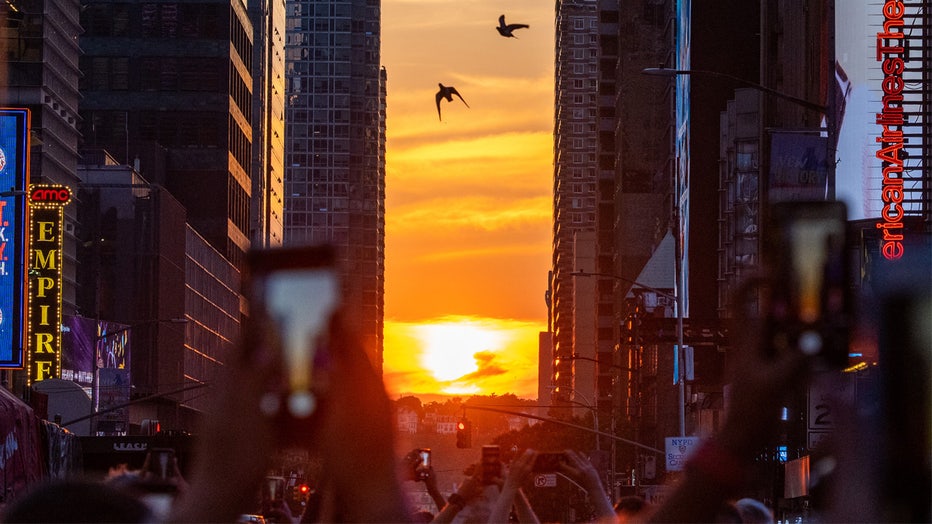Manhattanhenge 2024: Guide to best viewing times, places in NYC this weekend
Manhattanhenge 2024: What to know in NYC
Manhattanhenge 2024 continues tonight and this weekend in NYC!
NEW YORK CITY - Manhattanhenge 2024 continues tonight and this weekend in NYC!
JUMP TO: BEST VIEWING TIMES l BEST PLACES TO SEE l WEATHER FORECAST
The captivating event occurs when the sun sets perfectly in the center of Manhattan's east-west streets.
Here are some details about when and where you can witness it, as well as if the weather will hold up.
Manhattanhenge dates
Manhattanhenge does not take place on the summer solstice itself. Instead, it happens about three weeks before the solstice and again about three weeks after. That's when the sun aligns itself perfectly with the Manhattan grid's east-west streets.

NEW YORK, NEW YORK - JULY 11: Two birds fly through the middle of the street as people gather around to watch the sun set during Manhattanhenge in Times Square on July 11, 2022 in New York City. Manhattanhenge, which happened in May and now again in
The last Manhattanhenge will take place Friday, July 12 (Full sun) and Saturday, July 13 (Half sun).
Manhattanhenge best viewing times
The best viewing time for Friday is 8:20 p.m. For Saturday, the best viewing time is 8:21 p.m.
Where to see Manhattanhenge 2024
The traditional viewing spots are along the city's broad east-west thoroughfares:
- 14th Street
- 23rd Street
- 34th Street
- 42nd Street
- 79th Street
The Hayden Planetarium suggests finding a spot as far east as possible that still has views of New Jersey across the Hudson River. The sunset can also be viewed at Tudor City Overpass in Manhattan and Hunter's Point South Park in Long Island City, the planetarium said.
Manhattanhenge July 12: Weather in NYC today
For the full weather forecast, click HERE.
Where does the name Manhattanhenge come from?
Astrophysicist Neil deGrasse Tyson coined the term in a 1997 article in the magazine Natural History. Tyson, the director of the Hayden Planetarium at New York's American Museum of Natural History, has said that he was inspired by a visit to Stonehenge as a teenager.
The future host of TV shows like PBS' "Nova ScienceNow" was part of an expedition led by Gerald Hawkins, the scientist who first theorized that Stonehenge's mysterious megaliths were an ancient astronomical observatory.
It struck Tyson, a native New Yorker, that the setting sun framed by Manhattan's high-rises could be compared to the sun's rays striking the center of the Stonehenge circle on the solstice.
Unlike the Neolithic Stonehenge builders, the planners who laid out Manhattan did not mean to channel the sun. It just worked out that way.
Is Manhattanhenge an organized event?
Manhattanhenge viewing parties are not unknown. The beverage company San Pellegrino hosted an "exclusive Manhattanhenge celebration" on a bridge spanning East 42th Street in 2018.
But Manhattanhenge is mostly a DIY affair. People gather on east-west streets a half an hour or so before sunset and snap photo after photo as dusk approaches. That's if the weather is fine. There's no visible Manhattanhenge on rainy or cloudy days.
Do other cities have 'henges'?
Similar effects occur in other cities with uniform street grids. Chicagohenge and Baltimorehenge happen when the setting sun lines up with the grid systems in those cities during March and September, around the spring and fall equinoxes. Torontohenge occurs around Feb. 16 and Oct. 25.
But Manhattanhenge is particularly striking because of the height of the buildings and the unobstructed path to the Hudson.
The Associated Press wire services helped contribute to this report.

